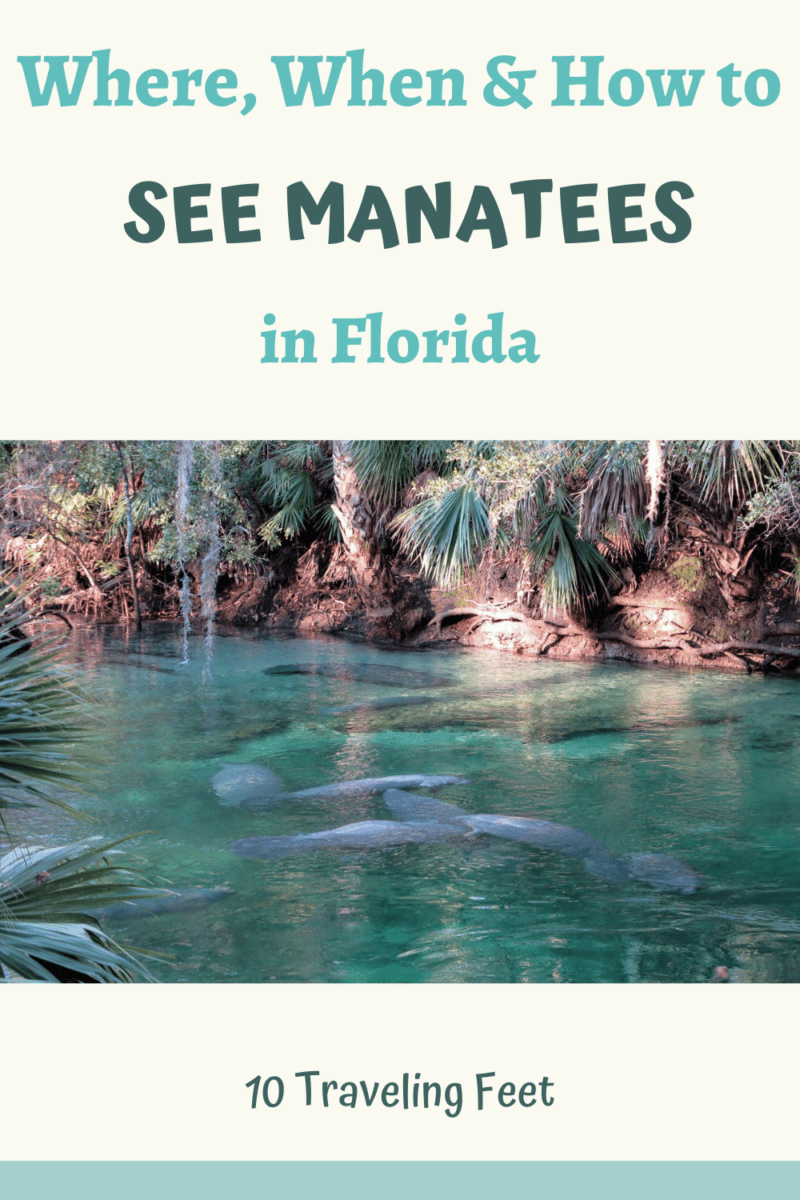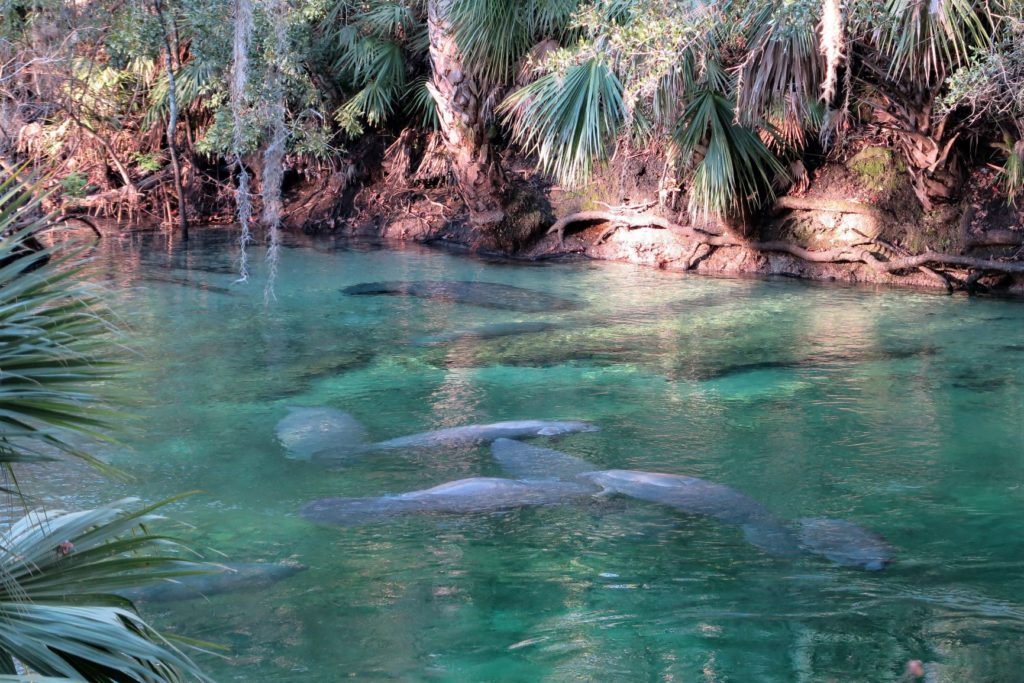
Spotting a Manatee in Florida, in its Natural Habitat, is Absolutely an Incredible Experience! And Knowing Simple Tricks on When, Where & How to Best See Manatees in Florida can be the Key for a Successful Sighting!
Manatees live year-round in Florida’s fresh waterways and all along the saltwater coast of the Atlantic and the Gulf of Mexico. Throughout much of the year manatees can be hard to find because they spend the majority of their time resting, eating or simply swimming while under the water.
In general, manatees will surface (just popping their nose out of the water) every 3-5 minutes to breathe, but they are also able to hold their breath for up to 20 minutes at a time! This can make them incredibly difficult to find.
Being from Florida, I have had the pleasure of seeing manatees out in the waterways my entire life. On most days, it really can be hit or miss on whether you are lucky enough get to see one, but don’t let that discourage you.
There are several simple things you can do that will significantly increase your chances at seeing a manatee in the wild. There’s even a couple of strategies that will practically guarantee a wild manatee sighting! These are the tips I would like to share with you!
In this Post:
Tips on How to Spot a Manatee in the Wild
Top 10 Places to Find Manatees in the Wild in Florida
Top 7 Places to See a Manatee at a Rehabilitation/ Captivity Site
Short on Time?
Bookmark or Pin This for Later
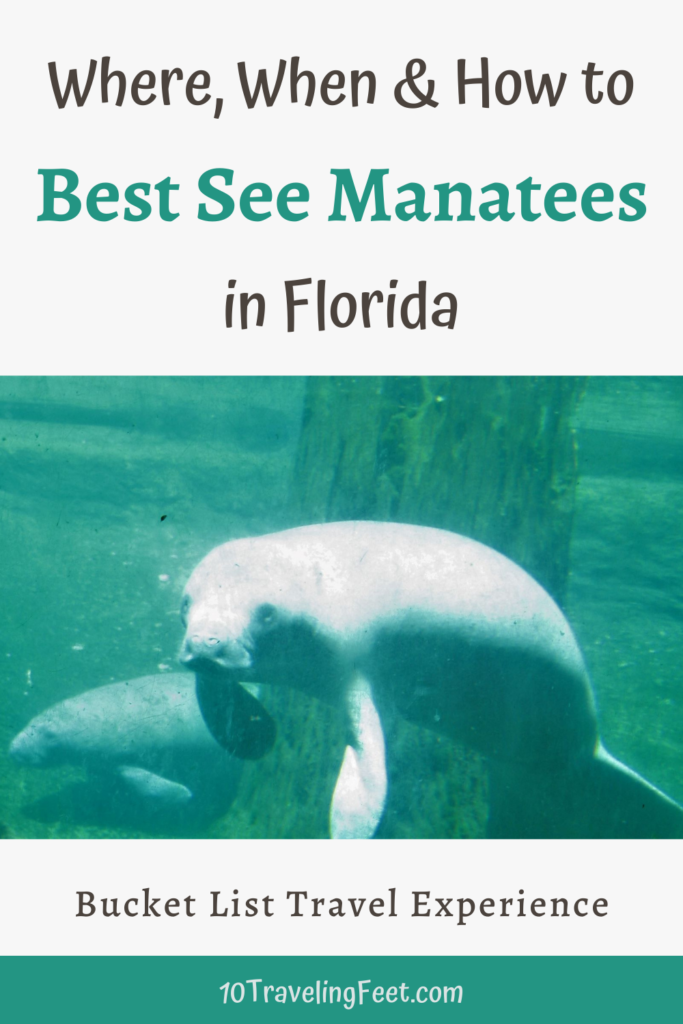
Tips on How to Spot a Manatee in the Wild
- Look for “manatee footprints.” Circular rings that appear in the water when a manatee surfaces.
- Search for bubbles rising to the surface. These bubbles could be from a manatee resting below.
- Listen for any sounds like a whoosh of air or a snort that occurs when a manatee takes a breath.
- Look for a snout or a flipper to pop up out of the water briefly.
- If you are out on the water, look straight down for any dark large oval shapes resting below.
- Polarized sunglasses will help you see manatees better under the water.
- Manatees tend to stay near the coastline or in rivers where they have food, so look here.
- For easier visibility, look for manatees in the crystal clear waters of one of Florida’s springs that connects to the Atlantic Ocean or Gulf of Mexico. (listed below)
Read on for more reasons why Florida’s springs are great places to look for manatees in the wild.
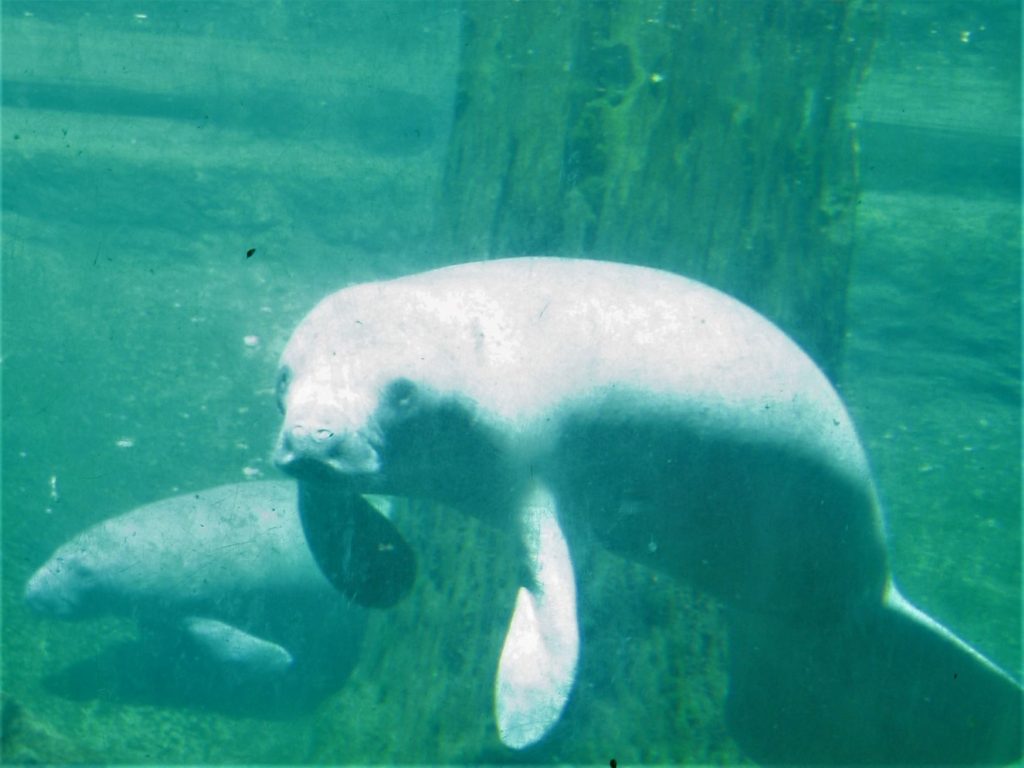
When to Best See a Manatee in Florida
Manatees Head to Florida’s Springs During Cold Weather!
Manatees cannot tolerate water temperatures below 68 degrees Fahrenheit for a long period of time. And so each winter (approximately mid-November to mid-March) they swim and congregate in the warmer waters of the Florida springs. These springs remain at a constant 72 degrees temperature year-round. Manatees also gather around the warmer waters of power plant outfalls.
This migration and gathering pattern makes them much easier to find during the winter months. The peak months for manatee sightings in Florida are in December, January and February. And the colder the day, the more manatees you will find in these warmer waters.
Overall, Your Best Bet to See a Wild Manatee in Florida is to:
Visit a Florida warmer water site (like the ones listed below) on a cold Florida day when the surrounding water temperature falls below 68 degrees Fahrenheit.
During these Times, You May Even Find Hundreds of Manatees Grouped Together! This is a Spectacular Site to See!
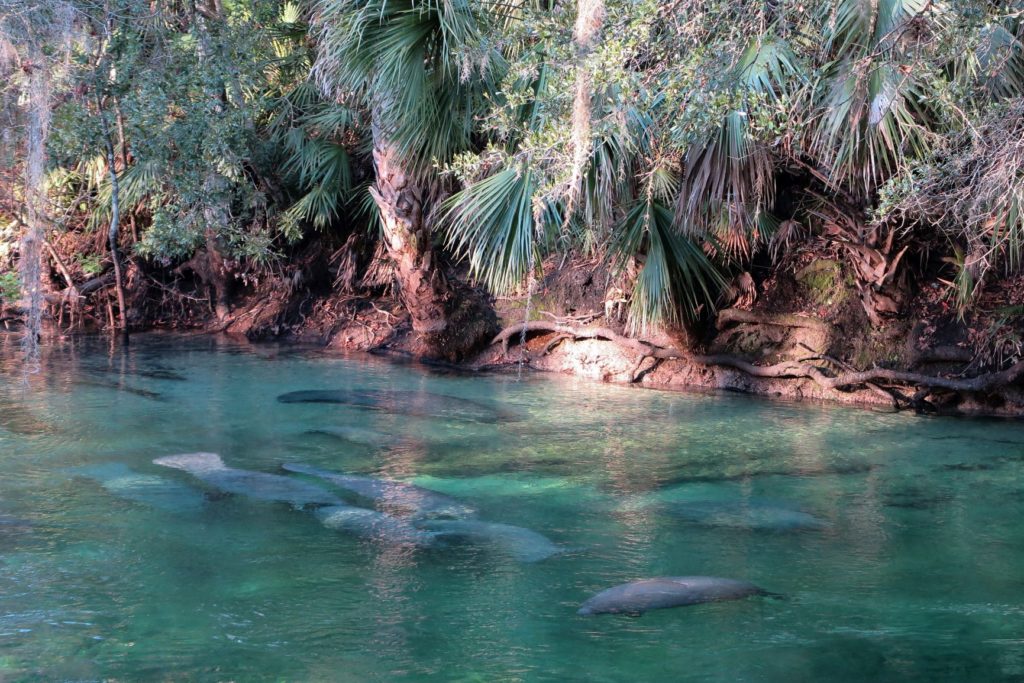
Manatee Fun Facts
Species: There are 3 species of manatee in the world & Florida is home to the West Indian Manatee.
Length: 8 to 13 feet long
Weight: 440 to 1,300lbs
Average Lifespan in the Wild: 40 years.
Diet: Herbivore (fresh water vegetation, sea grass & algae), manatees are also called “sea cows.”
Most Closely Related to: Elephants!
Conservation Status: Manatees are a Threatened Species. They have no natural predators but they still face threats from habitat loss, boating accidents, cold stress and entanglements with trash & fishing lines.
Conservation Efforts: Manatees are easier to find today than they were a just couple of decades ago. Thanks to incredible conservation efforts, the once endangered West Indian Manatee population has grown from ~1,200 manatees in Florida in 1991 to at least 5,700 and possibly up to 6,600 today!
Looking to Help: Join the Save the Manatee Organization
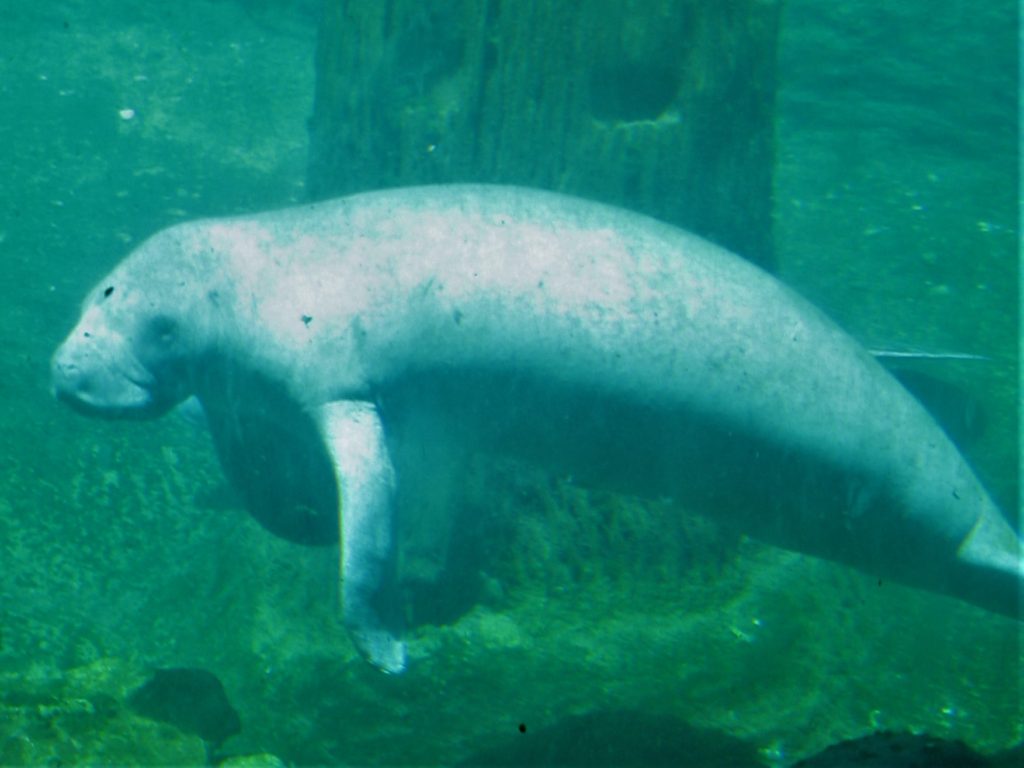
Where to Best See Wild Manatees in Florida
1. The Crystal River/ Kings Bay/ Three Sisters Springs Area
Discover the Manatee Capital of the World in Citrus County Florida!
This video was taken with an underwater camera attached to a monopod. We just put the pole into the water while kayaking near Three Sisters Spring and got some great video! We highly recommend doing this!
Location:
- Less than 1.5 hours north of Tampa on the West Coast of Florida.
Why Go:
- This is The Largest Natural Winter Refuge for Manatees in the World, Hosting as many as 800 Manatees each Winter!
- This area is the ONLY location in the United States where it is legal to Swim with Wild Manatees!
Know Before You Go:
- The Crystal River/ Kings Bay Area is made up of over 70 natural springs.
- Three Sisters Springs is the most popular due to its beauty and its land access to see the manatees.
- Other major springs here include King Spring, Tarpon Spring, Idiots Delight, Hunter Spring, Jurassic & House Spring.
- Crystal River National Wildlife Refuge & Kings Bay Manatee Refuge are specifically designated Manatee Protection Areas for the Threatened Florida Manatee.
- Crowds are quite common during the manatee season so we recommend visiting during the week or early in the morning if possible.
- Homosassa Springs (also in Citrus County) is ~15 minutes south of Crystal River, FL and has many manatee viewing/ swimming options as well.
- The best time to visit is on a cold Florida day when the Gulf of Mexico’s temperature is below 68 degrees, although manatees can be found year-round in these waters.
How to View Manatees from Land:
- Three Sisters Springs is the most beautiful spring system in Kings Bay. Here you can walk on a boardwalk to view the manatees in the springs. This is the only property in the area that provides land access to the Crystal River National Wildlife Refuge from November to March.
- Three Sisters Springs has an entrance fee to access their boardwalk. (Winter – Adults – $20, Children (6-15) – $7.50)
- Please note that there is no water access from Three Sister Springs.
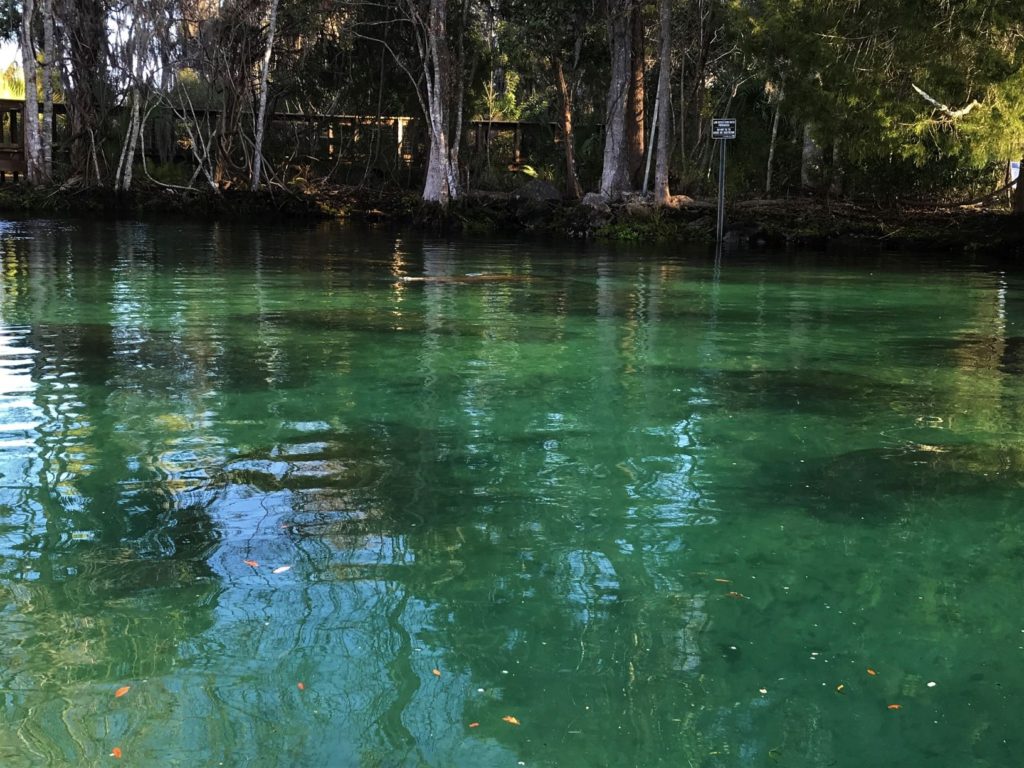
How to View Manatees from the Water:
(There is no entrance fee to view manatees from the water by Three Sisters Springs.)
Kayak with Manatees:
- Hunter Spring’s Park is a popular public launch site with kayak rentals available. This public park is ~1 mile by water to Three Sisters Springs. Please note that launching from this site requires requires kayaking across the slightly rougher water of Kings Bay if you are wanting to visit Three Sisters Springs. This is no problem at all for most people but if you have small children or are uncomfortable kayaking then check out Crystal River Kayaking Company. (If Kayaking, Please Always Follow the Guidelines for Kayaking Near Manatees.)
- Crystal River Kayaking Company is the closest dock to Three Sisters Springs and is approximately 8-10 minutes by kayak through calm canals. The only downside is that you will be kayaking through the canals of people’s “backyards” to get to the springs. (We love kayaking with this company because this calm water paddle allows our 2 older kids to paddle their own kayak without any problem on the way to Three Sisters Springs.)
Swim with Manatees:
- Numerous companies throughout Crystal River offer tours & gear (snorkels/ wetsuits) to swim with manatees in the 72 degree water. (If Swimming, Please Always Follow the Guidelines for Swimming Near Manatees.)
- You can also swim with manatees ~15 minutes south of Crystal River, along the Homosassa River. This is where we like to go because this area tends to be less crowded than the Crystal River area.
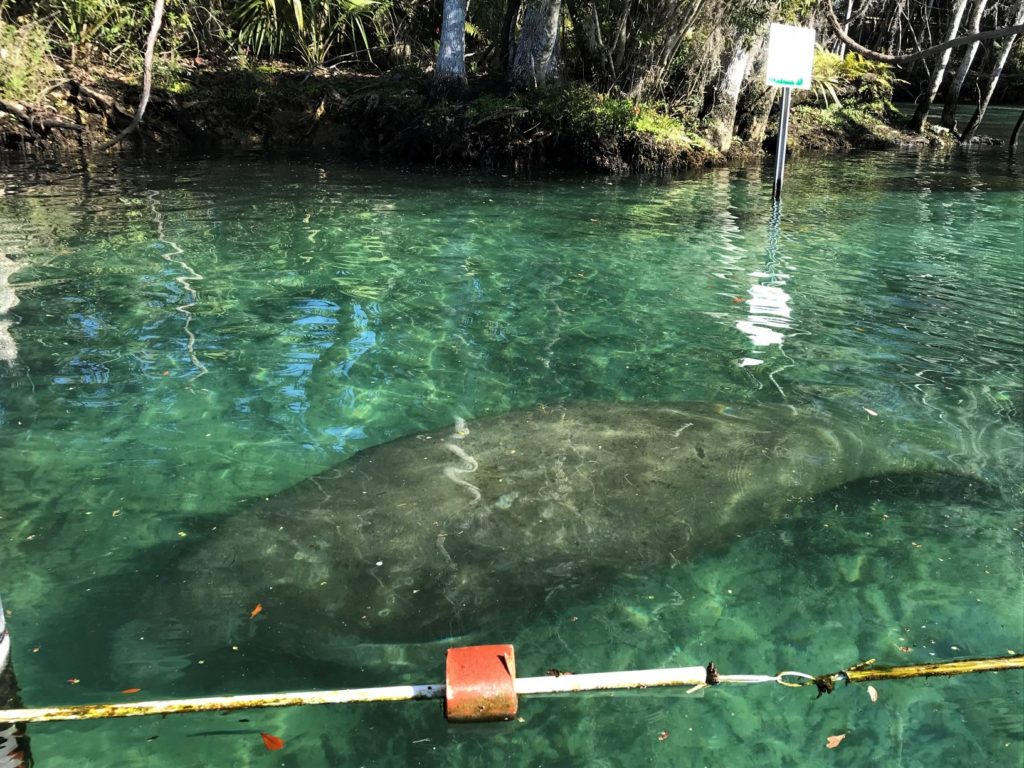
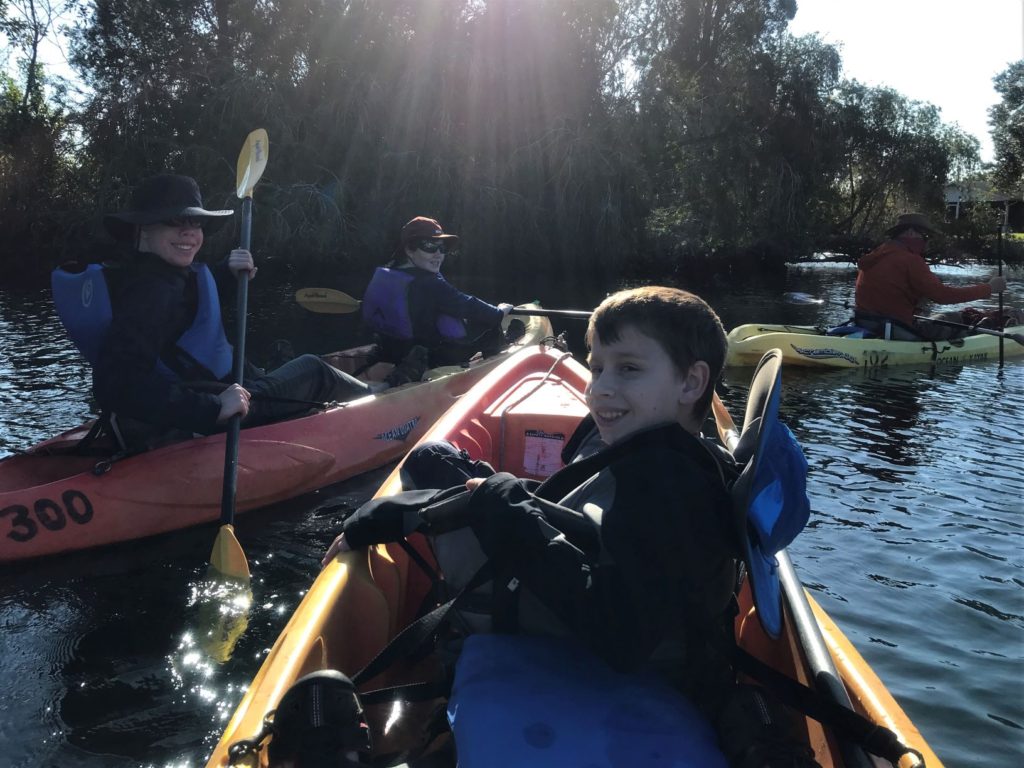
2. Blue Spring State Park – Orange City, FL
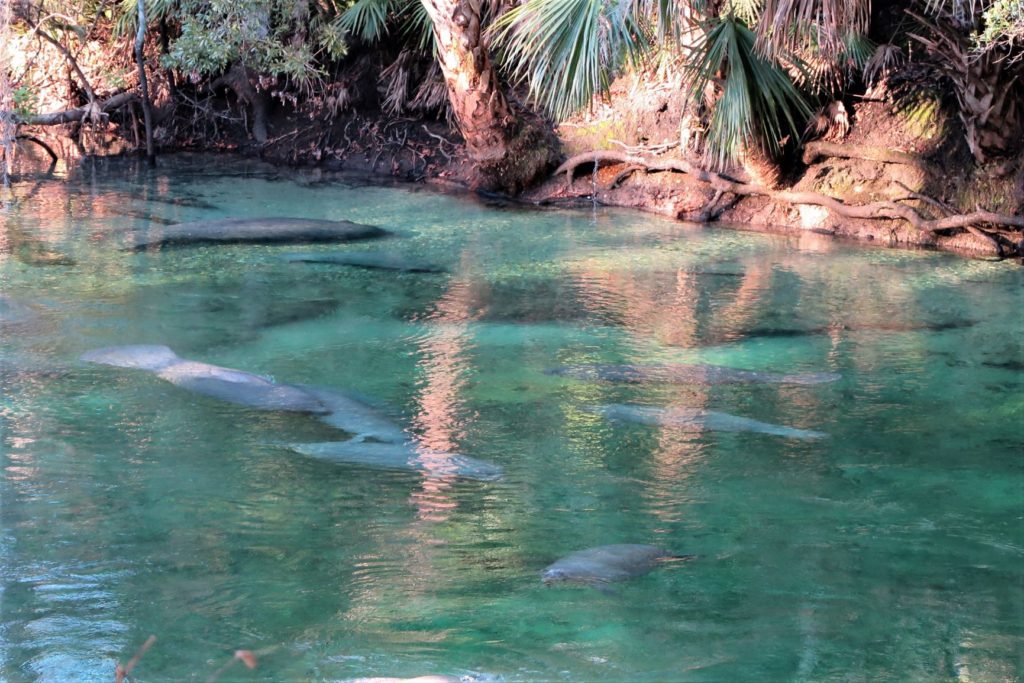
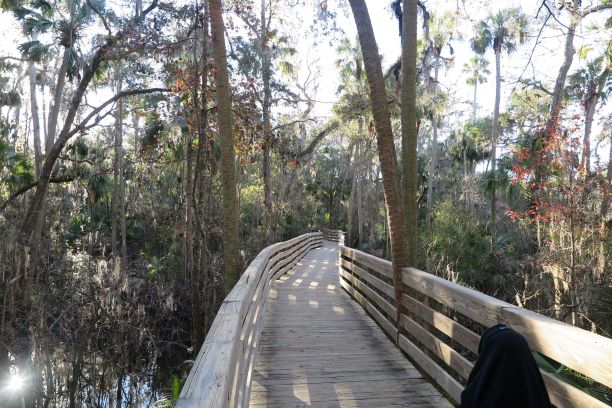
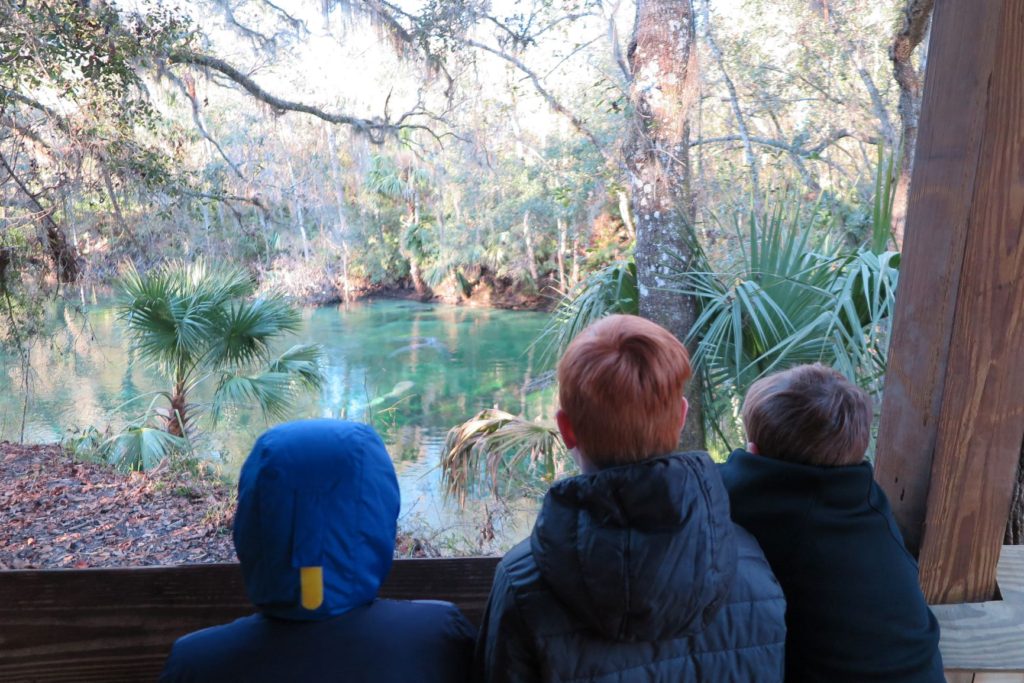
Location:
- Located approximately 40 minutes north of Orlando and 40 minutes west of Daytona Beach.
Why Go:
- Blue Spring is an Absolutely Gorgeous Blue-Green, Crystal Clear Spring where you can have a High Chance of Seeing Hundreds of Manatees Gathering on a Cold Florida Day!
Know Before You Go:
- From November 15th to the end of March, the spring is closed to all water activities for the manatee season. This includes swimming, kayaking, snorkeling, tubing, etc. (Guests cannot swim with manatees at Blue Springs.)
- Blue Springs Park frequently reaches capacity during the week and on weekends so visit early. (The park opens at 8am)
- Blue Spring State Park and the Save the Manatee Club work together to get daily manatee counts. These are available at savethemanatee.org or by calling Blue Spring State Park at 386-775-3663. This club also offers manatee webcams.
- Canoe/kayak rentals are available onsite from Blue Springs Adventures, but during the manatee season they are only allowed on the St. Johns River and not in the spring run.
- Other activities here include, hiking the 3.6 mile one way Pine Island Trail, boat tours of the St. John River and camping.
- There is a $6 per vehicle entrance fee to the state park.
How to View the Manatees:
- Take a stroll down the 0.4 mile long boardwalk that follows the Blue Spring run. This is where the manatees like to congregate in the 72 degree year-round spring waters.
- You can also look for manatees on a boat tour or by kayaking along the St. John River (but not in the Blue Spring Run during manatee season.)
The History of Blue Springs State Park and the Manatee:
- In 1970, researchers tracked 14 manatees in this spring run. (Two years later Blue Springs State Park was established.)
- By 2005, with manatee protection efforts, the wintering numbers of manatees exceeded 200.
- By 2018, this number skyrocketed to a record 485 manatees!
3. Tampa Electric’s (TECO) Manatee Viewing Center – Apollo Beach, FL
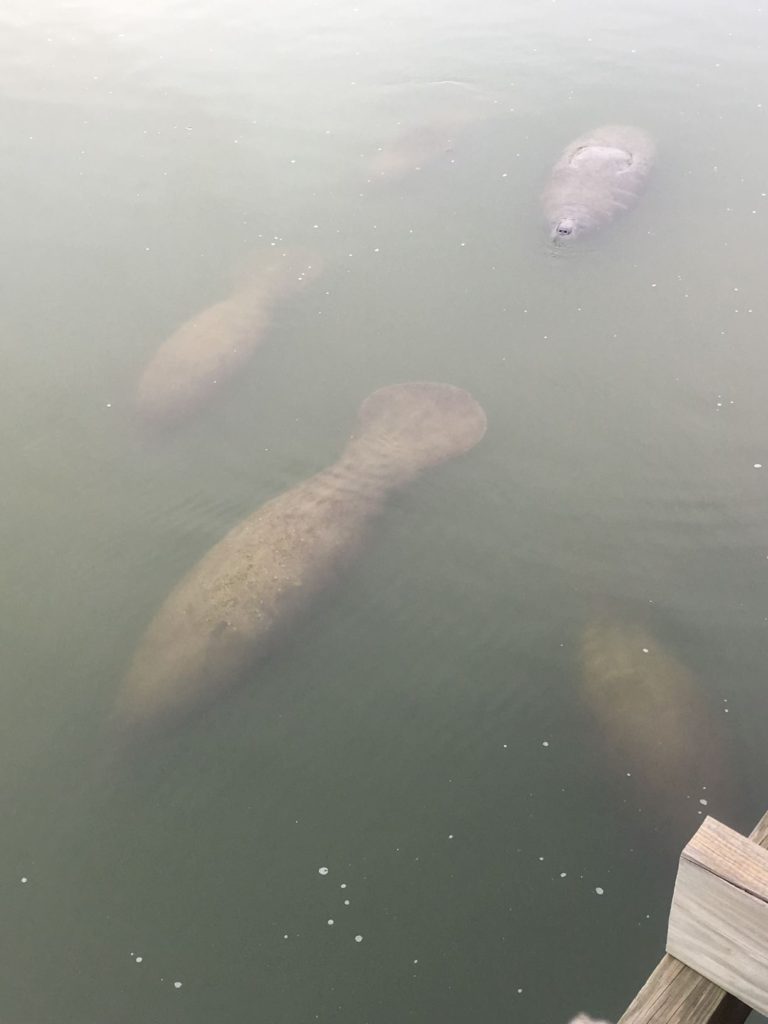
(Check for up to date closures due to Covid before you go.)
Location:
- Located approximately 20 minutes south of Tampa, FL
Why Go:
- This is a great site to see large gatherings of manatees on a cold Florida day, learn more about the manatee in the educational center and to be able to walk through coastal and mangrove Florida habitats on its ~1 mile trail.
Know Before You Go:
- Tampa Electric’s Manatee Viewing Center is scheduled to reopen next season on November 1st, 2021.
- Manatee sightings are highest when the Gulf of Mexico’s temperature falls below 68 degrees.
- Please note that the water is not clear here like it is in Florida’s springs.
How to View the Manatees:
- From the free parking lot, be prepared for the ~1 mile walk that takes you through coastal Florida habitats before reaching the Manatee Viewing Center.
- Along the trail you’ll find many informational signs regarding different plant species and you’ll find great views from the 50 foot Wildlife Observation Tower.
- At the Manatee Viewing Center, you’ll discover educational exhibits and of course lots of Manatees!
History:
- In 1986, after the construction of Tampa Electric’s Big Bend Unit 4, people began noticing manatees in large numbers congregating in the power station’s clean yet slightly warmed discharge waters on cold Florida days.
- Soon the Manatee Viewing Center was born and today this discharge canal is a state and federally designated manatee sanctuary that provides critical protection from the cold for these gentle giants.
Fun Fact:
- Keep an eye out for the leaping spotted eagle rays! This was an incredible site to see for our family and evidently it happens quite often. (Unfortunately I was not able to get a picture of it jumping out of the water.)
- But also, keep an eye out for jumping sharks! This I did get a picture of! This was further out along the trail, towards Tampa Bay, and I’ve read from other reviewers that this happens quite often as well! This was really exciting to see!
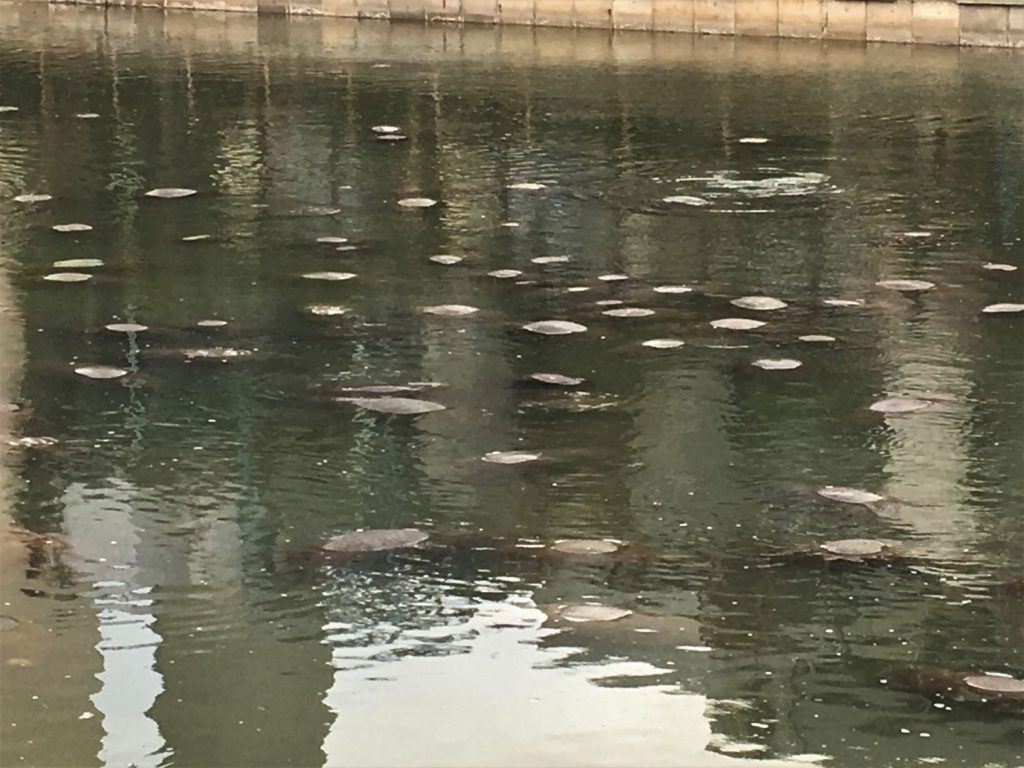
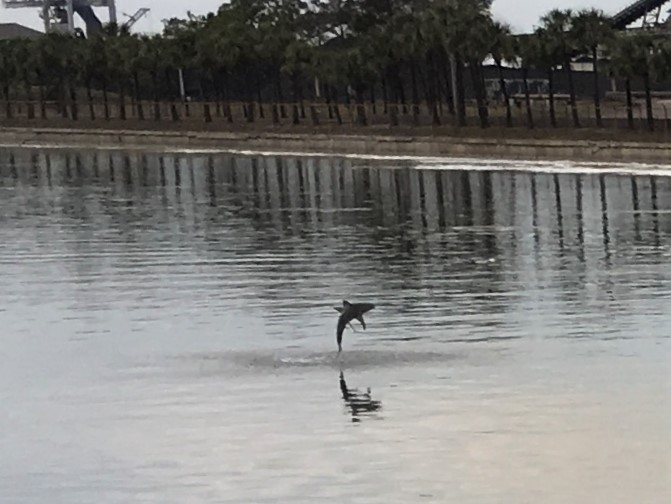
5. Edward Ball Wakulla Springs State Park – Wakulla Springs, FL
- Located 20 minutes south of Tallahassee, FL
- Home of the World’s Largest and Deepest Fresh Water Spring.
- Cost: $6 per vehicle entrance fee
- Look for manatees (especially from November to January) from the park’s diving platform or from the park’s 45-55 minute river boat tour.
- This park also offers a historic lodge, 9 miles of easy to moderate hiking trails and on rare occasions (when the waters are crystal clear) a glass bottom boat tour.
6. Lee County Manatee Park – Fort Myers, FL
- Located in Fort Myers, FL
- This park is right by the Florida Power & Light Power Station which discharges clean, warmer water into the Orange River.
- Hundreds of manatees visit Orange River and this canal during cold Florida days (when the Gulf of Mexico’s temperature falls below 68 degrees.)
- This park has several great manatee viewing points from land and has Kayak rentals available from the Manatee Kayaking Company too.
- There is a small fee to park.
7. Manatee Springs State Park – Chiefland, FL
- Located 1 hour west of Gainesville, FL
- Manatees congregate in the headwaters and spring run of the Suwannee River on cold Florida days.
- Stroll down the 800 foot boardwalk through a majestic cypress forest overlooking the breathtaking spring where manatees gather on cold Florida days.
- Canoes/ Kayaks are available to rent as well as pontoon boat tours through Anderson’s Outdoor Adventures.
- This park also has 8.5 miles of nature trails to explore on the North End Trail System that goes through cypress swamps, sinkhole ponds and uplands.
- Mountain Bikers can enjoy over 8 miles of wooded off road trails. (Bike rentals available on-site)
- Camping and fishing is available as well.
- There is a restaurant/ concessions onsite.
- Cost: $6 per vehicle
8. Merritt Island National Wildlife Refuge – Titusville, FL
- Shares the island with Kennedy Space Center in Florida
- View manatees from the an observation platform overlooking the Haulover Canal. (This canal was created between the Indian River and Mosquito Lagoon to give the manatees easier access between the two bodies of water.
- Again cold Florida days are the best times to spot manatees here.
9. Spring Bayou near Craig Parks – Tarpon Springs, FL
- Located 30 minutes north of Clearwater, FL
- Manatees visit this sheltered waterway near Florida’s Gulf Coast on cold Florida days.
- Limited parking is available at this small community park.
10. Manatee Lagoon – Riviera Beach/ West Palm Beach, FL
(Check for closures due to Covid before you go.)
- Located in West Palm Beach, FL
- Free educational center with hands-on activities that’s “all about manatees.”
- View manatees up close during the winter from the observation deck.
- Listen to a lecture, go on a lagoon tour or bring younger children to their Manatee Tales & Puzzle time.
- The Manatee Lagoon also hosts educational groups for children ages 10-13 called Lagoon Explorers (registration required). Here, they learn about how manatees migrate in the winter months and how to identify and safely interact with them!
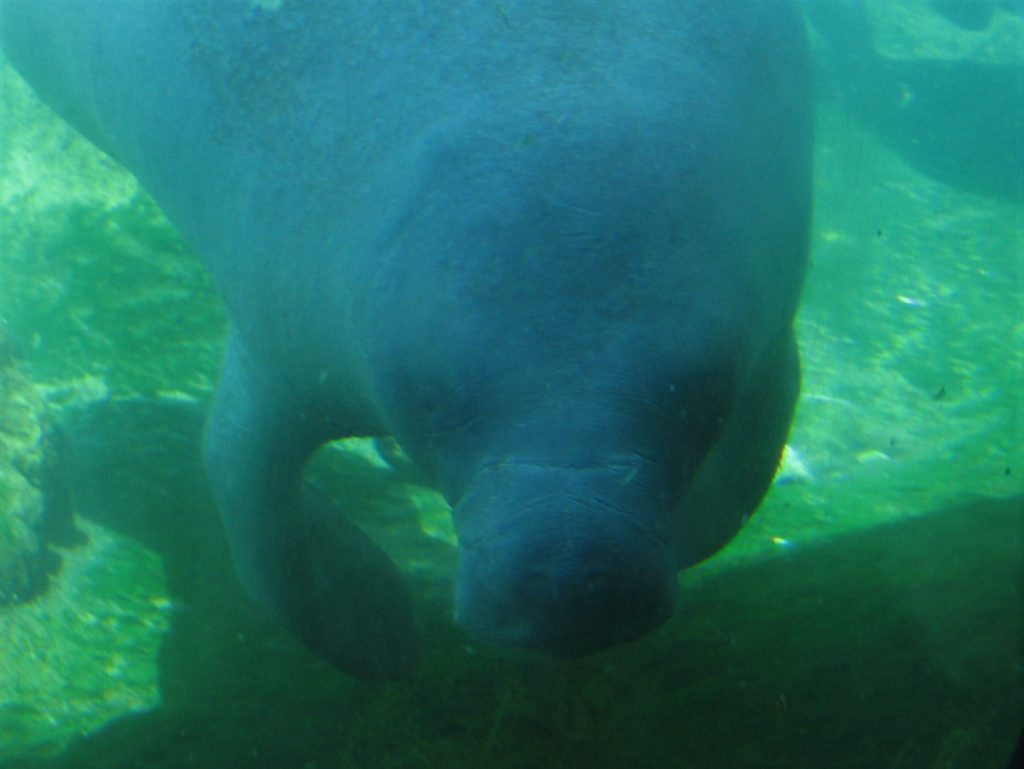
POPULAR TOURS WITH MANATEES
Please Follow the State Guidelines When Viewing Manatees
- Look, but don’t touch manatees. Also, don’t feed manatees or give them water. If manatees become accustomed to being around people, they can alter their behavior in the wild, perhaps causing them to lose their natural fear of boats and humans, which may make them more susceptible to harm.
- Do not pursue or chase a manatee if you see one while you are swimming, snorkeling, diving, paddling or operating a boat.
- Never poke, prod or stab a manatee with your hands, feet or any object.
- If a manatee avoids you, do not chase the animal for a closer view.
- Give manatees space to move. Avoid isolating or singling out an individual manatee from its group and do not separate a cow and her calf.
- Keep hands and objects to yourself. Don’t attempt to snag, hook, hold, grab, pinch, hit or ride a manatee.
- Avoid excessive noise and splashing if a manatee appears nearby. The manatee may be resting and may surface without being aware of your presence. Noise and activity may startle the animal awake, which may put it in harm’s way if it is frightened and leaves the area.
- If the site you visit allows in-water activities near manatees, use snorkel gear and float at the surface of the water to passively observe manatees. The sound of bubbles from SCUBA gear or other devices may cause manatees to leave the area.
Manatees are Protected by Law
The manatee is protected under federal law by the Marine Mammal Protection Act of 1972 and by the Endangered Species Act of 1973, which makes it illegal to harass, hunt, capture or kill any marine mammal. The manatee is also protected by the Florida Manatee Sanctuary Act of 1978, which states: “It is unlawful for any person, at any time, intentionally or negligently, to annoy, molest, harass, or disturb any manatee.”
Anyone convicted of violating this state law faces a possible maximum fine of $500 and/or imprisonment for up to 60 days. Conviction on the federal level is punishable by fine of up to $50,000 and/or one year in prison. The State of Florida can pursue prosecution under federal law in circumstances of extreme harassment, resulting in the death or injury of a manatee.
If you are unable to find a manatee out in the wild, or you are not traveling through Florida during the winter, but still want to see a manatee, then check out these top sites that provide homes and rehabilitation for manatees year-round.
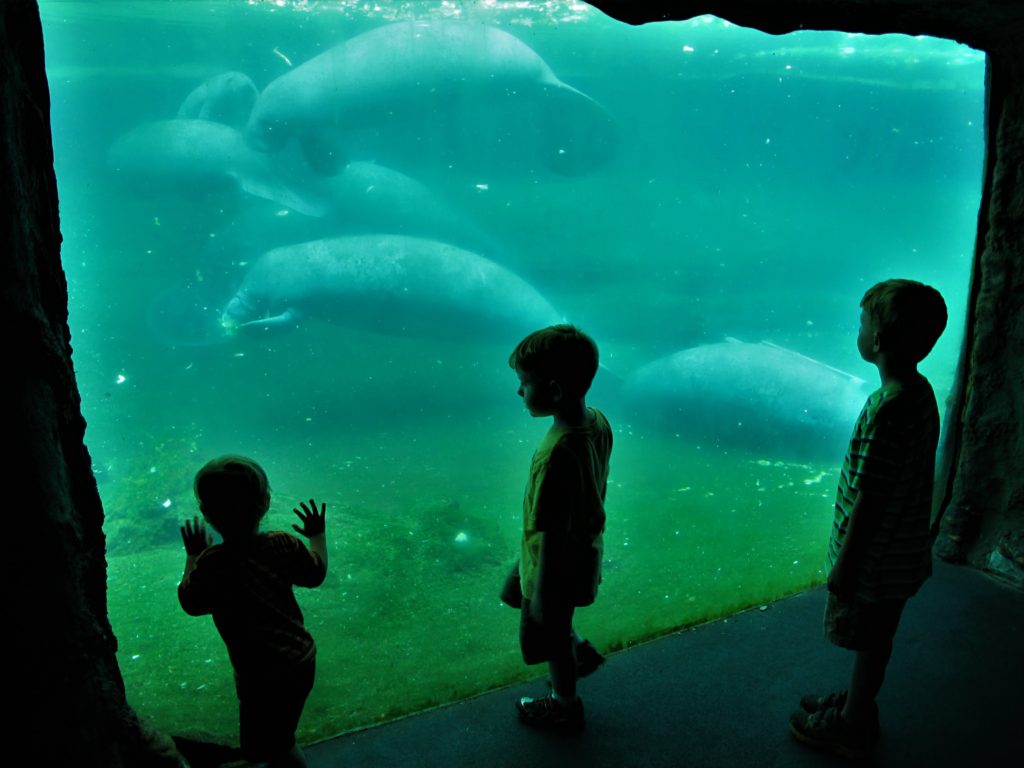
1. Ellie Schiller Homosassa Springs Wildlife State Park – Homosassa, FL
(Manatee Rehabilitation Center)
- Located just south of Crystal River and less than 1.5 hours north of Tampa, FL
- This park has 3 resident manatees (Ariel, Electra and Betsy) that are unable to survive on their own. There are daily educational programs and manatee feedings for them that occur four times daily. This is provided by park staff and volunteers.
- Possibly view wild manatees in an enclosed underwater viewing area near the spring basin.
- Other animals that you can see here include alligators, black bears, red wolf and an old hippopotamus. Each animal here is unable to survive in the wild on its own.
- The park also offers webcams through the Save the Manatee Club.
- There is a 1.1 mile trail that winds through the wildlife park.
- There is an entrance fee.
2. Mote Marine Laboratory and Aquarium – Sarasota, FL
(Manatee Research Center)
- Mote Marine Lab researches manatee biology, health, behavior and conservation efforts.
- See their two manatee residents, Hugh and Buffet. They are the only manatees in the world that are trained to participate in behavioral studies.
- There is also a dolphin, turtle and whale hospital here.
- See sharks, sting rays, reef animals, otters, sea turtles and more.
- There is an entrance fee.
3. Parker Manatee Aquarium – Bradenton, FL
(2nd Stage Rehabilitation Facility) – (The aquarium is located in the The Bishop Museum of Science and Nature)
- This aquarium provides a temporary home for up to three manatees designated for release back into the wild after being treated in an acute care hospital.
- View their manatees from above and below the water, listen to presentations and view educational exhibits on manatees.
- This is the former home to the oldest known manatee in the world, Snooty (1948-2017 at 69 years).
- Also visit the planetarium, the archaeological exhibits, maritime history exhibits, environmental exhibits, and more. (This is the largest natural and cultural museum on the Gulf Coast)
- There is an entrance fee.
4. Miami Seaquarium – Miami, FL
(US Fish and Wildlife Service Manatee Critical Care Facility)
- Miami Seaquarium has outside and underwater manatee viewing areas.
- This facility’s highly trained rescue and rehabilitation teams are recognized as national leaders in marine mammal care.
- You can also see other aquatic animals from sharks to sting rays to dolphins, sea turtles, penguins, seals and more.
- There is an entrance fee.
5. Zoo Tampa at Lowry Park – Tampa, FL
(Florida Manatee Non-Profit Aquatic Center/ Acute-Care Hospital)
- Zoo Tampa at Lowry Park has manatee exhibit and underwater observation area.
- There is an on-site hospital for manatee rehabilitation. (Over 430 manatees have been treated here in the last 25 years!)
- You can view tons of other animals here such as: orangutans, elephants, pygmy hippos, tigers, lemurs, and so many more. There are also great encounters such as the lorikeet feedings, rhino feedings, meet a giraffe and more!
- There is an entrance fee.
6. Sea World of Florida – Orlando, FL
(Animal Rescue and Rehabilitation Program)
- Sea World theme park has a manatee program, Marine Mammal Keeper Experience (for an extra fee), and viewing area. SeaWorld staff also assist with manatee rescues and rehabilitation.
- There are parking, entrance and possible program fees.
7. Epcot – Orlando, FL
- View manatees in “The Seas with Nemo and Friends” exhibit.
- There is a parking and entrance fee.
Wherever It May Be That You See Your First Manatee, Take a Moment to Appreciate How Incredible These Magnificent Creatures Are.
Let’s Help Protect Them So That Manatees Will Continue To Thrive In Our Waters. Let’s Make Sure That Future Generations Will Still Be Able To Admire Florida’s Gentle Giants, The Manatee.
I Hope You Find a Lot of Manatees With Your Traveling Feet!
If You Found This Post Helpful, Please Share / Pin It

Traveling with Kids & Looking for Great Books?
This post contains affiliate links, which means we may receive a small commission, at no cost to you, if you make a purchase through a link. Please Read Our Disclosure Policy. As always, I only share products with you that I use and love for my family. Thank you for supporting 10 Traveling Feet.
